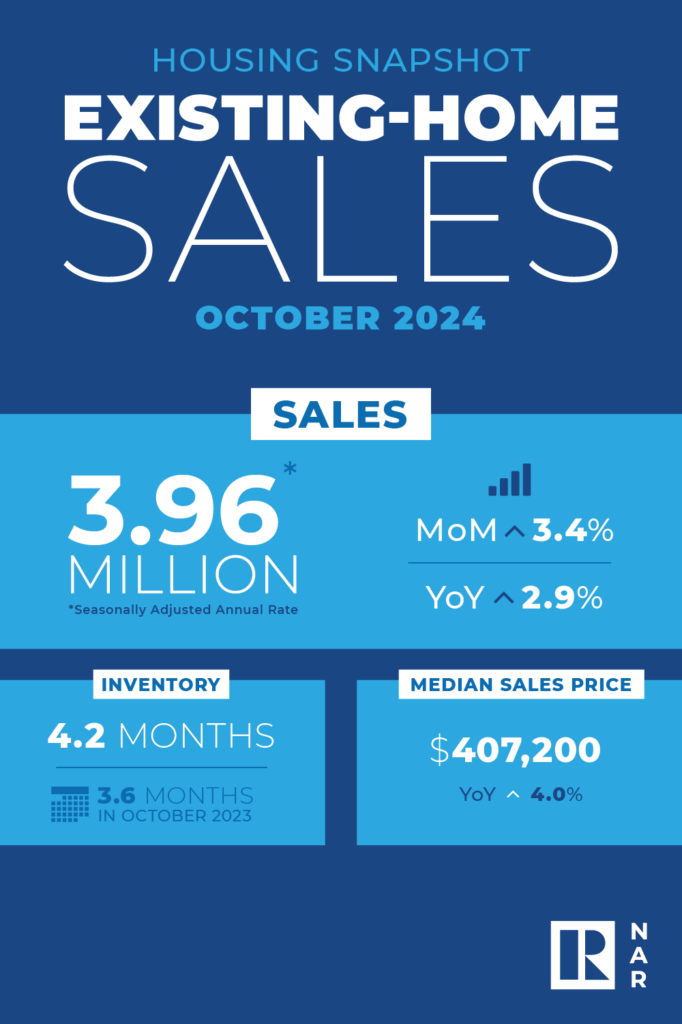The National Association of Realtors (NAR) reports that existing-home sales rose in October 2024, improving in all four major U.S. regions. Year-over-year, sales elevated in three regions, but were unchanged in the Northeast.
Total existing-home sales–defined by NAR as completed transactions that include single-family homes, townhomes, condominiums and co-ops–expanded 3.4% from September to a seasonally adjusted annual rate of 3.96 million in October. Year-over-year, sales progressed 2.9% (up from 3.85 million in October 2023).
“The worst of the downturn in home sales could be over, with increasing inventory leading to more transactions,” said NAR Chief Economist Lawrence Yun. “Additional job gains and continued economic growth appear assured, resulting in growing housing demand. However, for most first-time homebuyers, mortgage financing is critically important. While mortgage rates remain elevated, they are expected to stabilize.”

Supply on the Rise
Total housing inventory registered at the end of October 2024 was 1.37 million units, up 0.7% from September, and 19.1% from one year ago (1.15 million). Unsold inventory sits at a 4.2-month supply at the current sales pace, down from 4.3 months in September but up from 3.6 months in October 2023.
“The ongoing price gains mean increasing wealth for homeowners nationwide,” Yun added. “Additional inventory and more home building activity will help price increases moderate next year.”
Builder sentiment has improved for the third straight month, as builders expect that market conditions will continue to improve according to the National Association of Home Builders (NAHB). Builder confidence in the market for newly built single-family homes was 46 in November, up three points from October, according to the latest NAHB/Wells Fargo Housing Market Index (HMI).
As NAHB Chairman Carl Harris, a custom home builder from Wichita, Kansas explains, “With the elections now in the rearview mirror, builders are expressing increasing confidence that Republicans gaining all the levers of power in Washington will result in significant regulatory relief for the industry that will lead to the construction of more homes and apartments. This is reflected in a huge jump in builder sales expectations over the next six months.”
Prices Continue to Climb
NAR reports the median existing-home price for all housing types in October was $407,200, up 4% from one year ago ($391,600). All four U.S. regions registered price increases.
Existing-home sales in the Northeast in October 2024 grew 2.2% from September to an annual rate of 470,000, identical to October 2023. The median price in the Northeast was $472,900, up 7.6% from last year.
In the Midwest, existing-home sales bounced 6.7% in October to an annual rate of 950,000, up 1.1% from the prior year. The median price in the Midwest was $305,300, up 7.2% from October 2023.
Existing-home sales in the South climbed 2.9% from September to an annual rate of 1.77 million in October, up 2.3% from one year before. The median price in the South was $361,200, up 0.9% from one year earlier.
In the West, existing-home sales increased 1.3% in October to an annual rate of 770,000, up 8.5% from a year ago. The median price in the West was $627,700, up 4.4% from October 2023.
“The median home sales price climbed 4% compared to one year ago to $407,200, exceeding $400,000 for a seventh straight month,” added Realtor.com Chief Economist Danielle Hale. “Unsold housing inventory rose 0.7% from a year ago, but because of the stronger sales uptick, months supply slipped to 4.2. Still, this marks a fifth consecutive month of a ‘balanced’ reading in this metric that has been in seller-friendly territory for years.”
Who’s Buying?
NAR found that first-time buyers were responsible for 27% of sales in October, up from 26% in September, but down from 28% in October 2023. NAR’s 2024 Profile of Home Buyers and Sellers found that the annual share of first-time buyers was 24%, the lowest ever recorded.
Cash sales accounted for 27% of transactions in October, down from 30% in September and 29% in October 2023. Individual investors or second-home buyers, who make up many cash sales, purchased 17% of homes in October, up from 16% in September and 15% in October 2023.
Distressed sales–foreclosures and short sales–represented 2% of sales in October, unchanged from last month and the previous year.
The State of Rates
The relief that home buyers felt in September from a dip in mortgage rates was brief. In mid-September, for the first time in four years, the Federal Reserve cut its benchmark interest rate by a full half-point to a range of 4.75% to 5.0%. The move by Powell is in response to the fight against inflation, after the Fed kept rates at an all-time 23-year high for more than a year.
And many anticipated mortgage rates to fall further as the Fed decided to lower the target range for the federal funds rate by 1/4 percentage point to 4.5% to 4.75% in early November, marking the lowest level since March 2023. But after a slight dip in mortgage rates, they began to tick back up in October, giving back some affordability gains. Mortgage payments on a typical home purchase rose 2.8% month-over-month in October, after falling for four consecutive months. Still, monthly mortgage payments (using a 20% down payment) are down more than $100 per month compared to the peak in May, and are $179 less than in October of last year.
Currently, Freddie Mac reports the 30-year fixed-rate mortgage (FRM) at 6.84% as of November 21, 2024, up six basis points from last week when it averaged 6.78%. A year ago at this time, the 30-year FRM averaged 7.29%.
“October data show that mortgage rates continue to be an important mediator of home sales activity,” said Hale. “The sharp uptick in mortgage rates since September despite the Fed’s rate cuts is likely to weigh on home sales activity early in 2025.”
Click here for more on NAR’s October 2024 report on existing-home sales.





